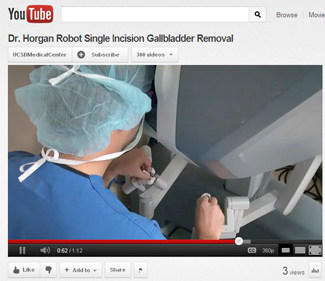
Robotic Surgery with One Small Incision, U.S. First
By:
- Jackie Carr
Published Date
By:
- Jackie Carr
Share This:
Article Content

Santiago Horgan, MD, chief of minimally invasive surgery, UC San Diego performing groundbreaking surgery. Click on photo to watch video of procedure.
On Tuesday, December 20th, Santiago Horgan, MD, chief of minimally invasive surgery at UC San Diego Health System was the first surgeon in the United States to remove a diseased gallbladder through a patient’s belly button with the aid of a new FDA-approved da Vinci Si Surgical System. With one incision, Horgan removed the gallbladder in 60 minutes. The patient returned home five hours after the groundbreaking surgery and reported minimal pain.
“Our goal is to offer surgery options that reduce discomfort, shorten hospital stays and minimize scarring,” said Horgan, a robotic surgery expert and director of the UC San Diego Center for the Future of Surgery. “With the aid of this robotic system, we can accomplish all three. This is a significant advancement for the 750,000 patients who need gallbladder removal each year.”
Intuitive Surgical, Inc. received FDA-approval on the new operating platform specifically for cholecystectomy procedures, the surgical removal of the gallbladder. The system enables surgeons to reduce the traditional number of incisions from 4-6 down to one incision that is less than an inch in length.
“What we have here is a convergence of new technologies and advanced surgical skills,” said Mark Talamini, MD, professor and chairman of surgery at UC San Diego Health System. “Instead of multiple incisions, we can operate through one small cut with tools that function with great precision in a narrow space. This is a win-win for the surgeon and patients.”
Horgan and Talamini are pioneers in minimally invasive surgery at the UC San Diego Center for the Future of Surgery. Together they have advanced single-site surgery as well as Natural Orifice Translumenal Endoscopic Surgery or NOTES. By operating through natural body openings, surgical teams at UC San Diego can remove diseased organs such as the gallbladder and appendix. Other options include esophageal surgery for achalasia and sleeve gastrectomy for obesity.
Surgeons at UC San Diego Health System utilize robotic surgical approaches for the treatment of bladder, colon, kidney, and prostate cancers, heart repairs, transplantation, heller myotomy, radical esophagectomy, hysterectomy and pelvic floor repairs for incontinence and prolapse.
NOTE: B-roll of this surgery is available for use by media.
Share This:
You May Also Like
Stay in the Know
Keep up with all the latest from UC San Diego. Subscribe to the newsletter today.


